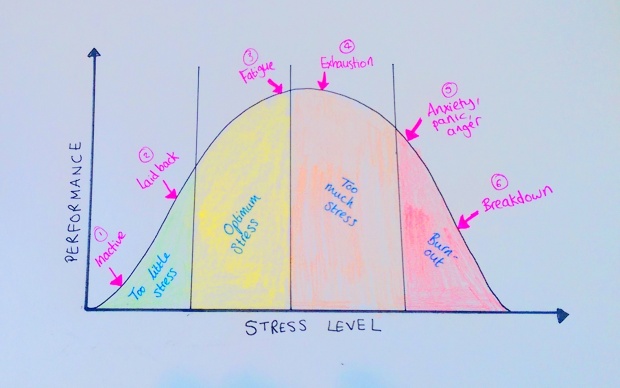Did you know that young children laugh spontaneously hundreds of times per day, while adults are lucky if they laugh just fifteen times in a day? Or that fifty years ago, adults laughed for approximately 18 minutes per day, but now we laugh, on average, only six minutes per day?
Laughter is important. Research shows that it helps to relieve stress, boredom, insomnia and depression, triggers the release of ‘happy chemicals’ or endorphins, regulates physical processes including breathing and digestion, and increases levels of happiness and quality of life. We’ve all heard that ‘laughter is the best medicine’, but how often do we think to treat ourselves to a good laugh? Mostly we perceive laughter as spontaneously occurring as a response to humour – but to wait for something funny to happen before we laugh, is to miss opportunities to integrate the therapeutic benefits of laughter into our lives every day. This is where laughter yoga comes in.
Last week at Gokula Vegetarian Cafe in Watford, Happiness Collective members tried an introductory laughter yoga workshop, led by Happiness Hero Lotte Mikkelsen of UnitedMind. Lotte is a laughter yoga master trainer and laughter coach, plus one of the happiest people I have ever met! It was fantastic speaking to her about her work and trying out laughter yoga exercises, which had us all crying with laughter and leaving feeling fantastic. We’d all like to send a huge thank you to Lotte for her brilliant workshop. Details about her upcoming events are at the bottom of this page.
What is laughter yoga?
To understand what laughter yoga is, we must first understand more about laughter. Lotte says “let’s clear up a few misconceptions about laughter: you must have a sense of humour to laugh, you have to have a reason to laugh, and you need to be happy to laugh”. In actual fact, you need none of those things to laugh!
“It is important to note that ‘laughing for no reason’ is different from laughing with humour. We are not born with a sense of humour but we are born with a pre-loaded ability to laugh” – Lotte Mikkelsen
Research has shown that the body cannot tell the difference between ‘real’ and ‘fake’ laughter, so simulating laughter brings about all of the same beneficial effects as genuine laughter. Laughter yoga is based on the principle of ‘acting happiness’; in other words, fake it until you make it! Laughter is contagious, and once you start laughing, even though it may be ‘fake’ at first, it soon becomes genuine!
During laughter clubs or workshops, the facilitator usually guides the group through different games, activities and exercises which emphasise fun, playfulness and openness within the group, to get everyone comfortable with each other and laughing freely. Seeing everyone else around you laughing so much is infectious and at our workshop, we all laughed non-stop for an hour! Breathing exercises are also included to deepen the benefits of laughter, and at the end of our workshop, we did a humming exercise to ground ourselves (some of us were feeling light-headed from all the laughter!)
Admittedly it did feel strange at first – you have to be willing to let go of inhibitions and look very silly! But in a safe, welcoming space, this is very liberating and highlights how little room we have for playfulness in our everyday lives.
What is the history of laughter yoga?
The first laughter club was started by Dr Madan Kataria in Mumbia in 1997. Interested in research into the healing effects of laughter, Dr Kataria started the first club with only five members, who would meet in a public park in the morning and tell jokes and stories to make each other laugh. The laughter was contagious and within three days, there were over 50 participants. Once the funny stories and jokes had started to run out, Dr Kataria realised that a different approach was needed to stimulate laughter and returned to his research. Finding that the body cannot tell the different between simulated and genuine laughter, he tried out some new laughing exercises with the group, which was the beginning of the laughter yoga now practised all over the world. He continued to develop these techniques, incorporating aspects of Pranayama yoga, to maximise the benefits of laughing. The popularity of laughter yoga quickly spread, and laughter clubs now run all over the world. In fact Lotte, who runs UnitedMind, trained with Dr Kataria to bring laughter yoga across the UK.
How can I incorporate laughter yoga into my life?
Laughter clubs can be found all over the UK and are non-profit, with all proceeds going to charity. Lotte offers laughter clubs in St Albans and Bushey, as well as workshops and training all over the UK. For more information and dates, please see her website UnitedMind.
Lotte also offers a telephone laughter club, where you can dial in and join a conference call of people laughing together! Her telephone laughter club was even featured in a BBC feature below, which also gives more information about laughter yoga and laughter clubs. For more details about her telephone laughter yoga, click here.
Finally, World Laughter Day is just around the corner! Come along for a celebration of the 10th World Laughter Day with a special UnitedMind event and try out laughter yoga for yourself. Taking place on Sunday 3rd May from 1 – 2.30pm at The Sopwell Nunnery Ruins, Cottonmill Lane, St Albans, AL1 2BY, with a donation of £5. For more details, see the Facebook event. Booking in advance is required; email lotte@unitedmind.co.uk to confirm.




